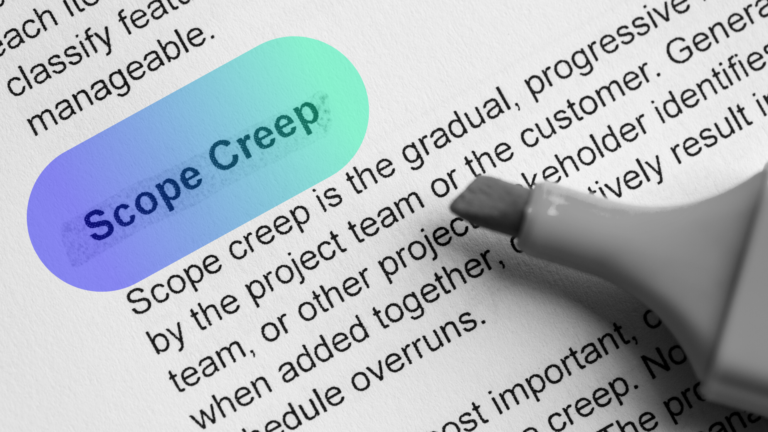The Silent Killer of Consulting Companies
As a consulting company, delivering projects on time, within budget, and meeting your client’s expectations is essential for success. Unfortunately, there’s a common problem that can throw a wrench in even the most well-planned consulting engagements… Scope creep.
So, what is scope creep?
Scope creep is when a project ends up becoming bigger than what was initially planned. This can happen for a number of reasons, such as not having clear project requirements, clients changing their priorities or goals, or due to poor communication between the consulting team and the client.
This can become a major problem for consulting companies, as it can negatively impact project timelines, and budget. Which can lead to the loss of clients.
Let’s take a closer look at why scope creep is such a problem for consulting companies, and what can be done to prevent it.
Why scope creep is a problem for consulting companies
There are several reasons why scope creep can be a problem for consulting companies.
Firstly, it can have a significant impact on project timelines and budgets. If the scope of a project expands beyond what was initially agreed upon, it can take more time and resources to complete, which can result in delays and increased costs.
Secondly, it can strain resources and the project team. The team may be required to work longer hours or bring in additional resources to manage the expanded scope, which if not correctly can negatively impact relationships with other clients.
Finally, scope creep can have a negative impact on client satisfaction and relationships. If the client feels that their needs are not being met or that the project is not progressing as expected, it can lead to frustration and disappointment. This can damage the consultant-client relationship and make it harder to secure future business.
Common causes of scope creep in consulting engagements
Now that we’ve established why scope creep is a problem, let’s take a look at some common causes of scope creep in consulting engagements. These include:
- Lack of clear project requirements: If the project requirements are not well-defined from the outset, it can be easy for the scope to expand beyond what was initially agreed upon.
- Client indecisiveness or changing priorities: If the client is indecisive or their priorities change during the course of the project, it can result in scope creep as new requirements are added.
- Poor communication between consultant and client: If there’s a breakdown in communication between the consultant and client, it can lead to misunderstandings about the scope of the project.
- Failure to manage client expectations: If the client’s expectations are not properly managed from the outset, it can lead to scope creep as they may expect more than what was agreed upon.
Identifying and preventing scope creep in consulting projects
So, how can consulting companies identify and prevent scope creep in their engagements?
Here are some best practices:
- Establish clear project goals and requirements: Make sure that the project goals and requirements are clearly defined from the outset and agreed upon by both the consultant and client.
- Conduct thorough project scoping and planning: Conduct a thorough scoping and planning process to identify potential risks and opportunities and to develop a detailed project plan.
- Set up a change management process: Establish a process for managing change requests, so that any proposed changes to the project scope can be evaluated and approved before they are implemented.
- Regular communication and status updates with the client: Maintain regular communication with the client throughout the project to keep them informed about progress, discuss any concerns or issues, and ensure that they are aware of any proposed changes to the project scope.
- Manage client expectations and set boundaries: Make sure that the client’s expectations are managed from the outset and that they understand the project scope and limitations.
How SystemX can help
Now that we’ve covered some best practices for preventing scope creep, let’s take a look at how SystemX can help consulting companies deal with this problem.
Project Tracking & Forecasting
One of the ways that SystemX can help with preventing scope creep is by enabling project managers to monitor project progress in real-time. This means that they can quickly identify if the project is deviating from the initial plan and take corrective action before the problem escalates. Specifically through SystemX’s AI powered forecasting features. This feature helps managers see cost and time trajectories before they become a serious issue.
Time Tracking & Expense Reporting
SystemX can also help with preventing scope creep by enabling accurate time tracking and expense management. This helps ensure that the project stays within budget and that clients are billed correctly for the work done.
Invoicing
Finally, SystemX can help with preventing scope creep by enabling project managers to generate professional and transparent invoices. This helps ensure that clients are billed promptly and accurately, reducing the risk of disputes that can lead to scope creep.
Final Thoughts
In conclusion, scope creep can be a major problem for consulting companies, but it can be prevented by establishing clear project requirements, conducting thorough project scoping and planning, setting up a change management process, maintaining regular communication with clients, and managing client expectations.
In addition, using a platform like SystemX can help consulting companies manage their projects more effectively, enabling them to monitor project progress, manage tasks and deadlines, track time and expenses accurately, and generate invoices quickly and easily.
By following these best practices and leveraging technology solutions, consulting companies can avoid scope creep and deliver successful projects for their clients.

